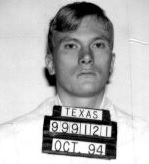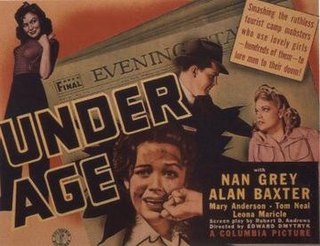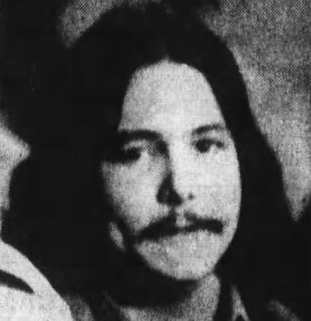
Lee Earle "James" Ellroy is an American crime fiction writer and essayist. Ellroy has become known for a telegrammatic prose style in his most recent work, wherein he frequently omits connecting words and uses only short, staccato sentences, and in particular for the novels The Black Dahlia (1987) and L.A. Confidential (1990).

Charles Denton "Tex" Watson is an American murderer who was a central member of the "Manson Family" led by Charles Manson. On August 9, 1969, Watson, Patricia Krenwinkel, and Susan Atkins murdered pregnant actress Sharon Tate, Jay Sebring, Wojciech Frykowski, Abigail Folger, and Steven Parent at 10050 Cielo Drive in Benedict Canyon, Los Angeles. The next night, Watson traveled to Los Feliz, Los Angeles, and participated in the murders of Leno and Rosemary LaBianca. Watson was convicted of murder in 1971 and sentenced to death. As a result of a 1972 California Supreme Court decision on the constitutionality in the state of the death penalty, he avoided execution but has remained incarcerated ever since.

My Dark Places: An L.A. Crime Memoir is a 1996 book, part investigative journalism and part memoir, by American crime-fiction writer James Ellroy. Ellroy's mother Geneva was murdered in 1958, when he was 10 years old, and the killer was never identified. The book is Ellroy's account of his attempt to solve the mystery by hiring a retired Los Angeles County homicide detective to investigate the crime. Ellroy also explores how being directly affected by a crime shaped his life - often for the worse - and led him to write crime novels. The book is dedicated to his mother.

Edmund Emil Kemper III is an American serial killer who murdered 8 people, including a 15-year-old girl, his own mother, and her best friend, from May 1972 to April 1973. Years earlier, at the age of 15, Kemper had murdered his paternal grandparents. Kemper was nicknamed the Co-ed Killer, as most of his non-familial victims were female college students hitchhiking in the vicinity of Santa Cruz County, California. Most of his murders included necrophilia, decapitation, and dismemberment.

Harvey Murray Glatman was an American serial killer active during the late 1950s. He was known in the media as the Lonely Hearts Killer and the Glamour Girl Slayer. He would use several pseudonyms, posing as a professional photographer to lure his victims with the promise of a modeling career.

Batman: Dark Victory is a 14-part American comic book limited series published by DC Comics, featuring the superhero Batman. The series, which ran from 1999 until 2000, was written by Jeph Loeb and drawn by Tim Sale, and it serves as a sequel to Batman: The Long Halloween. Batman: Dark Victory takes place primarily four to five years into Batman's career as a vigilante crimefighter. The plot centers on a series of murders involving Gotham City police officers by a mysterious serial killer only known as the Hangman. Central to the storyline is a territory war between Two-Face and the remnants of the Falcone mob, led by Sofia Falcone.

Jerome Henry "Jerry" Brudos was an American serial killer and necrophile who murdered at least four women in Oregon between 1968 and 1969. His killings are primarily known for centering around Brudos' fetish for women's shoes.

Jason Eric Massey was an American murderer who was executed in 2001 for the murders of two teenagers.

The Big Nowhere is a 1988 crime fiction novel by American author James Ellroy, the second of the L.A. Quartet, a series of novels set in 1940s and 1950s Los Angeles.

Eric Edgar Cooke, nicknamed the Night Caller and later the Nedlands Monster, was an Australian serial killer who terrorised the city of Perth, Western Australia, from September 1958 to August 1963. Cooke committed at least 20 violent crimes, eight of which resulted in deaths.
The Texarkana Moonlight Murders, a term coined by the contemporary press, was a series of four unsolved serial murders and related violent crimes committed in and around the Texarkana region of Arkansas and Texas in the late winter and spring of 1946. They were attributed to an alleged unidentified serial killer known as the Phantom of Texarkana or simply the Phantom Killer or Phantom Slayer. This hypothetical perpetrator is credited with attacking eight people, of whom five died, in a ten-week period.

Red Dragon is a psychological horror novel by American author Thomas Harris, first published in 1981. The story follows former FBI profiler Will Graham, who comes out of retirement to find and apprehend an enigmatic serial killer nicknamed "the Tooth Fairy". The novel introduces the character Dr. Hannibal Lecter, a brilliant psychiatrist and cannibalistic serial killer whom Graham reluctantly turns to for advice and with whom he has a dark past. The title refers to the figure from William Blake's painting The Great Red Dragon and the Woman Clothed in Sun.

Tommy Lynn Sells was an American serial killer. Though only convicted of one murder, for which he received the death penalty and was eventually executed, authorities believe he committed a total of 22 murders. Sells himself claimed on various occasions to have murdered over 70 people.
A copycat crime is a criminal act that is modelled after or inspired by a previous crime. It notably occurs after exposure to media content depicted said crimes, and/or a live criminal model.
James Clifford Carson and Susan Barnes Carson are American serial killers convicted for three murders between 1981 and 1983 in Northern California and the San Francisco Bay Area.

Appointment with Crime is a 1946 British crime film directed by John Harlow and starring William Hartnell, Raymond Lovell, Joyce Howard and Robert Beatty.

Under Age is a 1941 American crime film directed by Edward Dmytryk and starring Nan Grey, Alan Baxter, Mary Anderson, and Tom Neal.
In May and June 2018, a spree killer sought out and fatally shot six people in Scottsdale, Arizona, United States. The shooting spree began on May 30 and ended June 4, when the shooter killed himself as police closed in. The shooter was identified as 56-year-old Dwight Lamon Jones.
Gary James Lewingdon and Thaddeus Charles Lewingdon were American siblings and serial killers, who committed a series of ten murders in different Ohio counties from December 1977 to December 1978 for the motive of robbery. As a murder weapon, the criminals used .22 caliber pistols, due to which they received the nickname The .22 Caliber Killers. In 1979, both brothers were sentenced to several terms of life imprisonment.

Billy Lee Chadd is an American serial killer and rapist. Raised by two alcoholics, he began committing crimes at a young age, first getting into trouble with the law for a rape he committed when he was 15. Between 1974 and 1978, he raped and fatally stabbed two women in California. After being arrested for those crimes, he confessed to murdering a man at an apartment in Nevada and a male hitchhiker in Kansas, the latter claim never being verified. Initially sentenced to death for one of his murders, his sentence was appealed, and he was sentenced to life imprisonment at his retrial. He is now serving his sentences at a California state prison.














